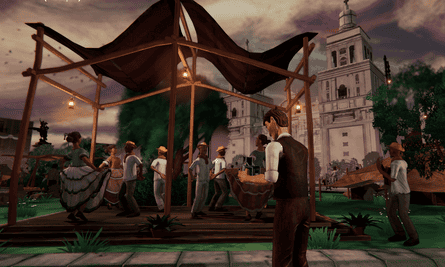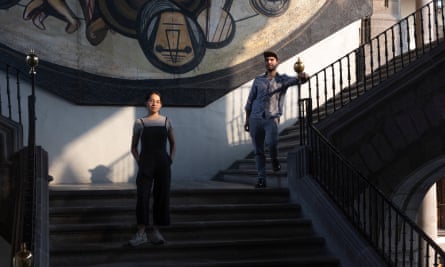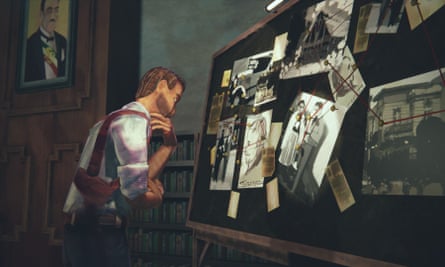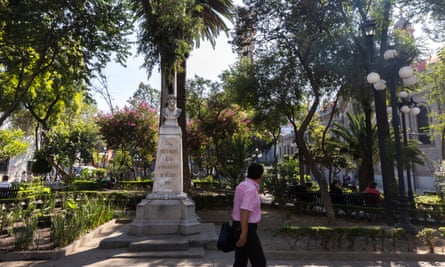Experience a unique history class with “Mexico, 1921: A Deep Slumber” where you become a journalist in the midst of a revolution.
H
How many tales are concealed within Diego Rivera’s murals? What was the experience of observing the birth of a contemporary Latin American country, attending classes on stridentism and surrealism? Riding a tram through a city lit by the aftermath of a recent revolution but plagued by frequent assassinations of presidents?
These are just some of the questions that brought a young team of video game developers back 100 years to Mexico, 1921.
Set in Mexico City following the Mexican revolution, Mexico, 1921: A Deep Slumber is an ambitious new docu-game from historical game factory Mácula Interactive. Weaving together watercolour skies and vibrant streetscapes with political history, national archives and affective design, the game takes players to a decadent and decisive decade in the country’s history as a timely hero: a journalist.
The setting for Mexico, 1921 follows Juan Aguirre, a 22-year-old from Puebla who relocates to Mexico City after the 1920 election of President Álvaro Obregón. He secures a job at the newspaper El Unilateral, named after the daily circular El Universal that was established in 1916 and later added a supplement focused on photography and illustration in 1922. As a new leader takes office, the country’s diverse population is experiencing a shift in cultural desires, signaling the beginning of a new era in Mexico.

During the years 1921-1928, the country undergoes a period of rebuilding after a seven-year-long civil war. Obregón’s political agenda, which includes promoting the new constitution, implementing a public education program, and aiding the rural working class, brings about a sense of renewal. However, the leader also amasses significant power and can easily sway public opinion through media coverage.
Using a typewriter and a medium-format camera, Aguirre is charged with becoming the most knowledgeable citizen of the city in order to report breaking news, track the movements of those in power, and collect the chisme – or gossip – that will aid him in solving the assassination of Obregón.
Santiago Pérez, the 32-year-old creator, states that the game is designed to symbolically explore specific aspects of Mexico such as its institutions, culture, and society. With a film-making background, Pérez initially wrote the script as if it were a movie. Later on, he assembled a diverse team with backgrounds in film production, cultural management, screenwriting, and history. None of them had experience in video game development prior to this project.
“In 1920, the media played a crucial role in influencing the discussion,” Pérez explains. “Having our main character as a journalist allows for access to those circles.”
The “analog” team, consisting of Pedro Álvarez-Luna as narrative coordinator, Paola Vera as game director, and Iñaki Pérez as scriptwriter, worked with the National Newspaper Archives to create a historically precise storyline. They utilized photographs, journal entries from intellectuals, and various news articles to ensure accuracy.

“We have attempted to create a historical storyline in the game that accurately portrays the various relationships and dynamics that were present during that time period. This includes the day-to-day activities, language used, and interpersonal connections between characters. Our goal is to make the story engaging and relatable, allowing players to connect with the character on a personal level,” explains Álvarez-Luna, who is 26 years old. “The modern Mexico that we know today was born during this era, as the concept of mexicanidad [Mexican identity] was developed and refined. This time period marked the beginning of Mexico’s formation as a nation.”
As Juan Aguirre, there are certain skills you must master, such as vetting sources at the Secretary of Public Education building, requesting off-the-record interviews at Zócalo plaza, and seeking out a variety of perspectives. Adopting a “metiche” or nosy attitude can help uncover important details and clues, similar to how Nancy Drew investigates. Keep an eye out for hints and opportunities to capture a compelling conversation or snap a front-page photo, or even discover a new spot to secretly listen in on government officials.
Every 16 hours, Mexico experiences an incident of violence towards a journalist or news organization, with the main culprit being the Mexican government. This dangerous state of journalism in Mexico is a recent development, with the post-revolution era being considered a key reference point by historians. The hostile treatment and discrimination towards the media were primarily instigated by the powerful political elite of the time, who eventually formed the Institutional Revolutionary Party (PRI).

Iñaki Pérez, a 27-year-old scriptwriter and historian, emphasizes the importance of preserving the role of the journalist. He believes that by portraying the human side of Juan, a journalist with a responsibility to fulfill, we can distinguish this profession from the rest of the media industry.
According to Dr. Bernardo Masini, a historian and provost for research and graduate studies at the Institute of Technology and Higher Studies (Iteso) in Guadalajara, newspapers were only read by a select group of businessmen, politicians, and intellectuals in 1921. The political elite were concerned with protecting their image among this influential circle. Masini notes that President Obregón openly claimed there was freedom of expression, and in return, the press showed their appreciation by supporting his political agenda. Masini, who has published a book on the press’s role during Obregón’s presidency, explains this dynamic further.
Pérez explains that the PRI, known for its authoritarian and repressive tactics, controlled all aspects of society including teachers, telegraph operators, railroad workers, and students. However, he believes this game has the potential to break this pattern and allow people to view this moment in history from a new perspective.
“Skip the promotion for the newsletter.”
after newsletter promotion

Juan’s daily work involves interacting with various historical objects such as magazines, novels, and a radio playing poems. He also has the opportunity to meet and engage with influential people from different fields, including muralist José Clemente Orozco, painter Roberto Montenegro, and surrealist couple Dr Atl and Nahui Olin. The game also features 35 other historical figures such as Félix Fulgencio Palavicini, founder of El Universal; José Vasconcelos, Mexico’s first minister of public education; and Esperanza Velázquez, one of the first female journalists in Mexico.
The Museum of Popular Art and Museo Casa Estudio Diego Rivera y Frida Kahlo assisted the game developers in creating virtual spaces that serve as museums. Within these locations, players can discover folk art and Mesoamerican artifacts, while also gaining knowledge about their origins. As part of the game, players can join in on the nation’s inaugural centennial festivities, visit a display at the original Cafe de Nadie, or explore the Convent of La Merced, a 16th-century cloister that is currently off-limits to the public.
According to 30-year-old game director Paola Vera, the true enchantment of the game lies not in the game itself, but in the experiences that follow after playing. She believes its worth lies in the unique opportunities it presents for blending art and history.
In the near future, specifically in early 2024, Mexico, 1921 will be launched before Mexico’s upcoming presidential election. Mácula’s goal is for Mexican gamers to feel a connection to their past through this game and also potentially use this perspective when considering their current situation.
Álvarez-Luna expresses their interest in not only individuals rediscovering details in their own lives, but also in how the game sparks interests and influences players’ perspectives on topics such as the media, information management, and citizenship.
Blanca Estela López, a professor of game psychology and design at SAE Institute México and the Metropolitan Autonomous University, believes that the rise of independent games in our country and throughout Latin America is a significant achievement. She notes that while there are many games featuring Mexican characters, they often fail to accurately represent the Mexican culture. López emphasizes the importance of having more games that accurately reflect the perspectives and voices of their creators.

The game has been exhibited at various events, including the London Games Festival, Latin American Games Showcase, Latinx Games Festival, Festival A Maze in Berlin, Pixelatl, IndieCade, Game Connection, Maquinitas (Ventana Sur), and the Fantastic Pavilion at the Cannes Film Festival last year.
Vera recalls that there were numerous skeptics who doubted our ability and criticized our idea. Santiago Pérez shares that the common advice was to create a simple game and complete it. However, we chose to disregard the first suggestion and instead followed the second. In just two and a half years, we not only successfully created a video game, but we also feel that we have functioned as a learning institution. We are proud to be shaping an industry.
According to Álvarez-Luna, a lesson from the game is that individual decisions, group ambitions, or conflicts between groups may be interesting gossip, but they also have a real impact on everyday people. The game Mexico, 1921 aims to teach players to pay attention to subtleties, think critically, and be more aware of these issues.
Source: theguardian.com